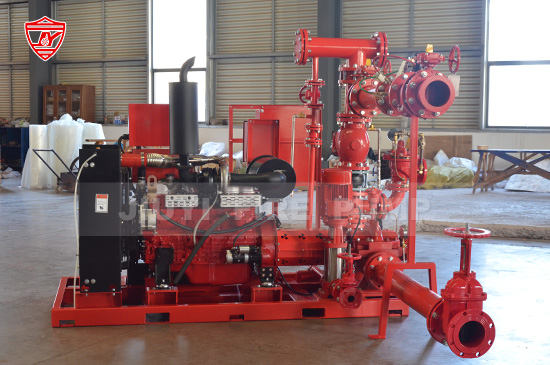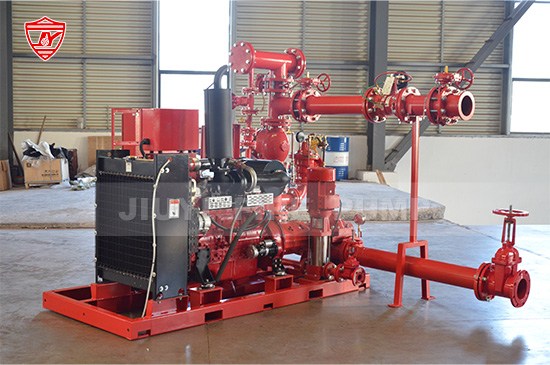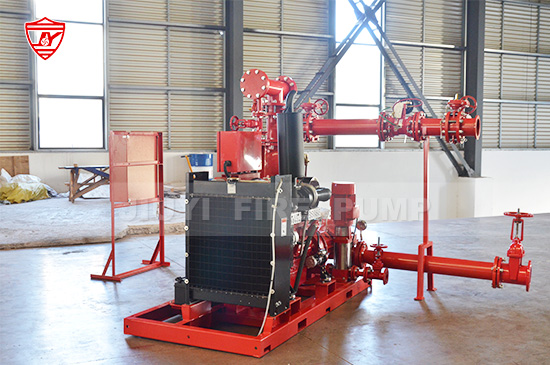A reliable fire protection system is one of the most critical safety measures for any building, whether it’s a commercial complex, residential tower, warehouse, or industrial facility. At the heart of this system lies the fire pump, a key component responsible for supplying adequate water pressure during a fire emergency.
Selecting the right fire pump isn’t just about choosing the right size or type—it involves understanding your building’s fire protection needs, applicable regulations, and technical specifications. Choosing the wrong pump can lead to insufficient water supply, non-compliance with NFPA 20, or even system failure during an emergency.
In this guide, we’ll walk you through how to select the right fire pump for your building step by step, helping you make informed decisions that ensure safety, reliability, and compliance.

A fire pump is designed to boost water pressure in fire protection systems when the existing water supply cannot provide adequate flow or pressure. Fire pumps are typically required in:
High-rise buildings where gravity-fed pressure is insufficient
Large warehouses with extensive sprinkler systems
Industrial facilities with significant fire risks
Commercial buildings with multiple fire zones
By delivering the necessary pressure, a fire pump ensures that sprinklers, hose reels, and hydrants operate effectively during a fire.
Before selecting a fire pump, it’s crucial to understand compliance requirements:
NFPA 20 – The National Fire Protection Association’s standard governing fire pump installation and performance.
UL Listed – Ensures the pump has passed rigorous safety and performance tests.
FM Approved – Confirms the equipment meets high reliability standards for insurance and fire safety.
For international projects, local building codes may also impose specific requirements. Always confirm compliance with your Authority Having Jurisdiction (AHJ).
Choosing the right fire pump starts with understanding your building’s unique requirements. Key factors to consider include:
Residential: Lower demand but must comply with local fire codes.
Commercial: Often require higher capacity pumps due to multiple fire zones.
Industrial: Typically need large-capacity pumps and redundancy systems.
High-rise buildings usually require fire pumps capable of delivering higher pressures to overcome vertical lift, while large warehouses may need higher flow rates for widespread sprinkler coverage.
Based on NFPA classifications, determine if your building is:
Light Hazard (e.g., offices, residential)
Ordinary Hazard (e.g., retail stores, schools)
Extra Hazard (e.g., manufacturing plants, chemical storage)
The hazard class affects the required water flow rate and pump size.

There are several types of fire pumps, and selecting the right one depends on your system design and water source.
Most common type for commercial applications
Easy to install and maintain
Suitable for high-capacity systems
Ideal when water is sourced from wells, tanks, or lakes
Common in industrial and municipal projects
UL/FM certified vertical turbine fire pumps are preferred for reliability
Compact design for limited space
Cost-effective for small to medium applications
Space-saving vertical design
Common in retrofit projects where floor area is limited
Deliver extremely high pressures
Suitable for very tall high-rise buildings
Choosing the right pump type depends on both water source and system demand.
Fire pumps are typically powered by electric motors or diesel engines.
Lower maintenance and operating cost
Require reliable power supply
Preferred in buildings with stable grid connections
Independent from grid power
Essential in areas with unreliable electricity
Require more maintenance and fuel storage
In some high-risk facilities, both electric and diesel pumps are installed for redundancy.
Two key parameters determine the right fire pump size:
Based on the sprinkler system design, hydrant requirements, and hose reel demands
Larger buildings and higher hazard classifications require higher flow rates
Depends on the building height and pipe friction losses
NFPA 20 provides formulas for calculating minimum required pressures
Working with a qualified fire protection engineer ensures accurate sizing and compliance.
The performance of your fire pump is closely tied to the available water source:
Municipal Water Supply: Most common but may require pressure boosting
Storage Tanks: Used when municipal pressure is insufficient
Lakes, Rivers, or Reservoirs: Often paired with vertical turbine fire pumps
Testing the water source capacity and reliability is essential to ensure uninterrupted fire protection.
For critical facilities like hospitals, data centers, and manufacturing plants, having a backup fire pump is highly recommended. Options include:
Jockey Pumps: Maintain system pressure to reduce frequent starts of the main fire pump
Standby Pumps: Installed as a redundant pump to meet NFPA 20 recommendations
Redundancy ensures uninterrupted fire protection even in the event of equipment failure.
A fire pump’s performance depends not only on its selection but also on its installation and maintenance:
Choose pumps with accessible layouts for inspection and servicing
Ensure proper alignment, piping, and electrical connections
Implement a preventive maintenance program, including weekly tests and annual flow testing
Partnering with a manufacturer who offers end-to-end support—from selection to commissioning and maintenance—can ensure long-term reliability.
Not all fire pumps are created equal. When safety is at stake, choose a manufacturer with:
UL Listed and FM Approved products
Proven experience in fire protection systems
Global compliance knowledge and technical support
Selecting a reliable manufacturer ensures that your fire pump meets stringent safety standards and delivers consistent performance.

Selecting the right fire pump for your building requires careful consideration of building requirements, regulatory standards, water supply conditions, and system design. By understanding your options—from pump types and power sources to flow and pressure calculations—you can make informed decisions that ensure safety, reliability, and compliance.
At Better Technology Group, we manufacture a full range of UL Listed and NFPA 20-compliant fire pumps, including electric fire pumps, diesel engine fire pumps, jockey pumps, and vertical turbine fire pumps. Our engineering team provides expert guidance to help you choose the right fire pump tailored to your project’s needs.